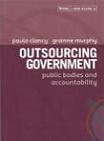Outsourcing Government - Public bodies and accountability

Our research shows that Public Bodies are core to our State system of governance and have long since ceased to be merely an adjunct to the main work of Government, conducted within the central civil service. Many are extremely significant in the public functions they perform, the scale of public expenditure they control and their sheer size as public sector employers. However, an absence of good information systems means that accurate assessment of their nature, scale and significance is difficult to establish.
Despite their central significance to the State, effective accountability structures for Public Bodies has historically been poor and may if anything have worsened. Accountability to parent Departments is poorly developed; judicial interpretations of the legal and constitutional framework combined with strong political control by the Government Executive means that Ministers can avoid responsibility, while the various calls for stronger Oireachtas scrutiny have been largely unsuccessful.
Ireland has in the past twenty-five years developed a body of legislation and regulation providing transparency and accountability directly to the public. We examined the most significant of these in some detail. But paradoxically, the inconsistent and ad hoc manner in which this legislation is applied has subverted at least some of the value of these measures. Many Public Bodies are excluded from coverage by one or more of these measures or are included in an ad hoc, inconsistent and or partial way. Furthermore, the measures themselves have been put in place under a variety of rules and formats which create inconsistency and confusion. The difficulties we encountered in trying to map the application of accountability and transparency measures to any Public Body apply equally to all types of bodies, executive, advisory and temporary taskforce. However, there are strong indications that much less regulation applies to advisory bodies than to executive bodies and virtually none at all in respect of the functioning of temporary taskforces.
There is something in the region of 5,000 appointments to Public Bodies at national level alone, the majority in the gift of Government. Given the number of these appointments and the importance of the function which the appointees must perform, it is a big gap in our accountability structure that Ireland has no clearly established mechanism to ensure that appointments are free from undue political or other influence or that there is an effective independent appointments system in place. As of now, ministers and senior civil servants are responsible for appointing the majority of members to Public Bodies. Moreover, the influence of the Oireachtas in the making of these public appointments is negligible.
Finally, there are no effective mechanisms to ensure representation of the diversity of the Irish population: gender balance at 25 per cent, is still short of the 40 per cent guideline established in 1991.
Overall, the present system of appointment to Public Bodies effectively gives elite groups a monopoly of such positions and therefore an inordinate degree of influence on decision making in the State. The recent report of the Democracy Commission has made a series of recommendations on how to address this which includes an independent system of appointments, with a role for the Oireachtas in the most important appointments and clear criteria and systems overseen by the Standards in Public Office Commission and the parent Department.
The unplanned and ad hoc mushrooming of Public Bodies combined with the lack of good information about them is bad for democracy. The very existence of these agencies in the ad hoc and fragmented manner in which they have grown up adds a further layer to the bureaucracy of government, constraining an individual citizen's ability to interact with an agency from which they are seeking a public service. The case has now been persuasively and repeatedly made for a strategic overview to be taken of Public Bodies, in accordance with clear criteria. This overview should include an ongoing review of the rationale for their existence as well as adequate mechanisms for maintaining operational and strategic oversight.
It is now more than forty years since the absence of a clear strategy for the establishment of Public Bodies has been identified as a key problem in urgent need of reform. In the Irish context the mix of reasons 'never formally listed' which lie behind the decision to set up each Body goes a long way to explaining the unwieldy, overlapping, and incoherent system we have today. A number of good arguments can be made for outsourcing of public functions to Public Bodies, arguments which are based on sound principles of democracy and efficiency/effectiveness (McGauran et al, 2005). However, delivering these positive outcomes is less easy in practice and is particularly difficult in the absence of a clear strategy.
The issue of public accountability is central to current political debate and one which is seen to be exercising the media and the wider public to a considerable degree.Historically, departmental and parliamentary oversight of Public Bodies has been less than effective and our analysis shows that it is rife with problems of inconsistency, exclusions and lack of clarity. Ensuring that accountability legislation is applied fully to all bodies responsible for public functions and that any exceptions are in accordance with clear criteria agreed in an open, transparent and accountable manner is clearly called for. This kind of action combined with a review of the basis on which accountability institutions themselves have been established would go far to combat the problems of opacity and impenetrability and the residual culture of secrecy. It is essential if formal accountability measures are to be meaningful in practice.